

The Biology Corner
Biology Teaching Resources

Use Beets to Explore Membrane Permeability
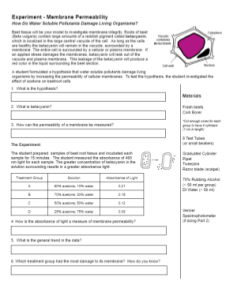
Beet tissue will be your model to investigate membrane integrity. Roots of beet (Beta vulgaris) contain large amounts of a reddish pigment called betacyanin , which is localized in the large central vacuole of the cell. As long as the cells are healthy the betacyanin will remain in the vacuole, surrounded by a membrane.
The entire cell is surrounded by a cellular or plasma membrane. If an applied stress damages the membranes, betacyanin will leak out of the vacuole and plasma membrane. This leakage of the betacyanin will produce a red color in the liquid surrounding the beet section.
What kinds of things cause stress to the cell?
Pollutants in the water, like alcohol or acetone, can cause the the pink betacyanin to leak out of the membrane. Color changes in the solution indicate the weakening of the membrane. In this lab, students will expose beet cores to different concentrations of alcohol and record the color change in the surrounding solution. Generally, I do this lab with my older, AP Biology students. It is included with a unit on the cell and cell membrane.
Overview of the Experiment
In the first section of the lab, students read background information on beets. They analyze data showing how the absorbance of light changes at different concentrations of acetone. In general, the greater concentration of acetone, the darker the solution of betacyanin.
In the second part of the lab, students cut disks from a beetroot core (about 1 cm). I use a cork borer to make cylinders, then the students use a razor blade or scalpel to cut each cylinder into 1 cm sections. You can distribute the materials in a petri dish which can contain some of the mess. Warning, the betacyanin from beetroot can stain clothes and skin.
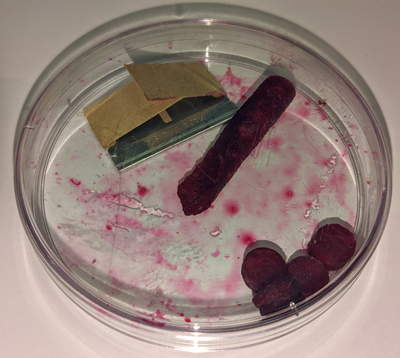
Students place their beetroot disks into test tubes containing different concentrations of alcohol. I use test tubes, but you could also substitute cups or beakers. The instructions include how to dilute the alcohol, starting with a 70% isopropyl alcohol solution. This is the concentration of alcohol that can be purchased cheaply at drug stores. Basically, students add water to dilute the solution to 25%. They will use a control solution of just water to compare results.
Analyzing Data
Students will rank the color of the solution from dark red to light pink. This type of qualitative data is easy to obtain if you don’t have expensive equipment to measure light absorbance. Generally, students will be able to see a darker color of pink when the alcohol concentration is high.
If you have access to a spectrophotometer , students can gather quantitative data showing the absorbance of light. In the second part of the lab, students design their own experiment to test other types of stress, such as heat. They gather data and write a lab report that outlines their procedure, results, and conclusions.
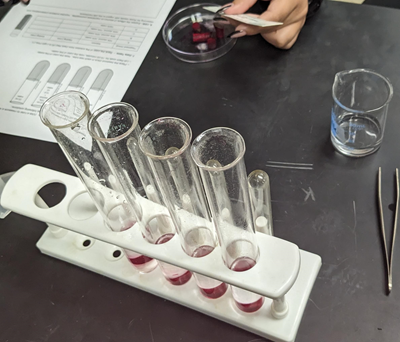
Shannan Muskopf


Practical Biology
A collection of experiments that demonstrate biological concepts and processes.
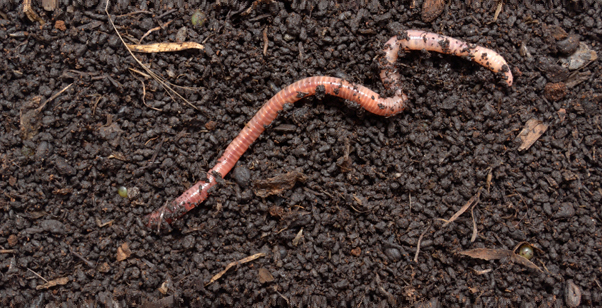
Observing earthworm locomotion
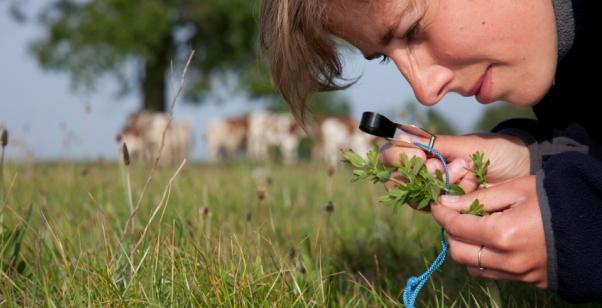
Practical Work for Learning
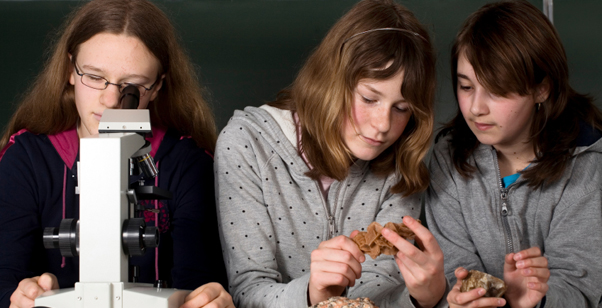
Published experiments
Investigating the effect of temperature on plant cell membranes, class practical.
You and your students may be familiar with the observation that colour leaks out of beetroot when it is cooked. Many cookbooks suggest that beetroot should be cooked with their outer skins on, and with a minimum amount trimmed from the top (by the leaves) and tail (by the taproot) to reduce the release of beet colour leaking into the water.
Lesson organisation
This procedure lends itself to detailed evaluation, and provides an opportunity to discuss how you would like students to write up a practical.
Cutting the cores to size and placing in water baths takes only a few minutes. During the thirty minutes heating (or chilling) time, you can discuss writing up or evaluating the procedure.
If you have access to only one colorimeter, one group could gather quantitative results while the others gather subjective, qualitative information. The number of beetroot cores used will depend on the number of water baths available.
Students can work individually or in pairs. To save time, reduce the number of temperatures used and collate results to provide repeats at each temperature.
Apparatus and Chemicals
For each group of students:.
Beetroot cores, cut with a size 4 cork borer and soaked in distilled water overnight ( Note 1 )
Thermometers, 1 for each water bath
Kettle, to provide boiling water for the water baths
Ice bath (a beaker of water surrounded by ice)
Scalpel, 1, or sharp vegetable knife
Forceps or mounted needles to ‘handle’ beetroot cores
Ruler, up to 15 cm, 1
Distilled water, in wash bottle
Measuring cylinder, 10 cm 3 , 1
Test tubes, 1 for each temperature of water bath
Paper towels
For the class – set up by technician/ teacher:
Access to several water baths set at a range of temperatures, or beakers containing water at different temperatures ( Note 3 )
Health & Safety and Technical notes
Always carry cutting tools in a small tray. Cut away from you. Replace the cutting tool in the tray when not in use.
Read our standard health & safety guidance
1 Beetroot must be raw, not cooked. Use a size 4 cork borer and cut with care using a cutting board. Cut enough cores to make eight 2 cm lengths per working group. Leave the cores overnight in a beaker of distilled water. The pigment from any cells that have been cut by the cork borer will leak into the water. Rinse away any pigmented water in the morning and replace with fresh water.
If you do not have a cork borer, cut the beetroot with a bread slicer (or onion slicer) to make even-sized slices, then cut the slices into even-sized chips. If beetroot is not available, use discs of red cabbage. You will need ten or more discs for each tube. If it is not possible to prepare beetroot in advance, students could cut the cores/ chips at the start of the lesson, wash in distilled water and blot dry.
2 Note: Beetroot juice will stain clothing (and, temporarily, skin) but is not hazardous. Students may wish to wear labcoats to protect their clothing from stains.
3 Check the temperature of the water baths regularly and top up with boiling water or add extra ice if the temperature has changed.
SAFETY: Take care carrying scalpels or knives around the laboratory. Always carry in a tray.
Preparation
a Cut bores of beetroot with a size 4 cork borer and soak overnight in a beaker of distilled water ( Note 1 ).
b Set up a series of water baths at different temperatures.
Investigation
Procedure c Collect 3 or 4 beetroot cores from the beaker provided. Cut each core into 2 cm sections until you have enough for one core for each temperature of water bath that you will be using. Put your 2 cm sections into a test tube with plenty of distilled water.
d Label a set of test tubes (one for each temperature of water bath) with the temperature and your initials. Add exactly 5 cm 3 of distilled water to each test tube and place the tubes, one in each water bath, for 5 minutes to equilibrate to the water bath temperature.
e Remove the beetroot cores from the distilled water and blot gently on a paper towel. Decide whether forceps or mounted needles are best for handling the tissue and what damage this might cause to the cores.
f Place one 2 cm beetroot core into each test tube and leave in the water bath for 30 minutes.
g After 30 minutes, shake the test tubes gently to make sure any pigment is well-mixed into the water, then remove the beetroot cores.
h Describe the depth of colour in each test tube. A piece of white card behind the tubes will make this easier to see. Arrange the tubes in order of temperature of the water bath. Describe any relationship between the amount of pigment released from the beetroot and the temperature.
i If you have access to a colorimeter, set it to respond to a blue/ green filter (or wavelength of 530 nm) and to measure absorbance. Check the colorimeter reading for distilled water.
j Measure the absorbance of each tube and plot a graph of absorbance against temperature. Describe any trends or patterns in your results.
Teaching notes
The dark red and purple pigments in beetroot are located in the cell vacuole and are chemical compounds called betalains . The pigments cannot pass through membranes, but can pass through the cellulose cell walls if the membranes are disrupted – by heat (for example cooking), by surfactants, or after a long period pickled in vinegar.
Questions 1 and 2 on the student sheet ask the students to produce a hypothesis about the beetroot cells and make a prediction. Then they have to evaluate the procedure and see if they think it is a valid test of the hypothesis and will produce reliable results. They may wish to alter the procedure in the light of their thoughts.
The procedure allows for students to identify systematic and random variables. It is a good opportunity to practice graphical treatment of results, including standard deviation error bars to assess the variation in repeats.
Students can work individually or in pairs. To save time, it might be a good idea to suggest that the number of temperatures used is reduced and students combine results to provide repeats at each temperature.
Here is a sample of results obtained with a colorimeter – measuring transmission of light at 530 nm (rather than absorbance).
Health & Safety checked, May 2009

IMAGES
COMMENTS
The betalains pigment was contained in the vacuole of the beetroot cells. The cell membrane contains the contents of the cell like a barrier. The cell membrane is made up of the phospholipid bilayer and protein molecules. These proteins are made up of linked amino acids. The hydrogen bonds within the protein determines its 3D shape.
Test the effects of pollution on membrane permeability using beetroot cores. Collect qualitative data (color) and quantitative data with spectrophotometers. ... It is included with a unit on the cell and cell membrane. Overview of the Experiment . In the first section of the lab, students read background information on beets. They analyze data ...
The Effect of Temperature on Membrane Permeability in Beetroot Cells. Abstract The cell membrane is a semi-permeable membrane with a phospholipid bilayer embedded with proteins. ... There were some control variables in the experiment. The size of the beetroot discs needed to be kept the same, 3mm. The amount of beetroot discs on each stack ...
The protein in the membrane can be denatured by heat. Beetroot cells containbetalain, a bright red, water soluble pigment, in the cell vacuoles. If the cell membranes are damaged the pigment can escape from the cells and can be detected in an aqueous medium around the tissue. Beetroot grows in soil at a temperature of between 10 - 15. o. C ...
A typical A Level membrane permeability experiment involves investigating the influence of a named variable on the membrane permeability of a vegetable such as beetroot (Beta vulgaris).Common variables to investigate are the effect of solvents or temperature because both of these factors can change the fluidity of the membrane.
The permeability of cell membranes is affected by several factors such as . Temperature; pH; The effect of such factors on membrane structure and permeability can be investigated using beetroot. Beetroot cells contain a dark purple-red pigment; The higher the permeability of the beetroot cell membrane, the more of this pigment leaks out of the cell
The pigments cannot pass through membranes, but can pass through the cellulose cell walls if the membranes are disrupted - by heat (for example cooking), by surfactants, or after a long period pickled in vinegar. Questions 1 and 2 on the student sheet ask the students to produce a hypothesis about the beetroot cells and make a prediction.
permeability of the membrane usually lead to the death of the cell. In this experiment, we will study the effects of changes in the environmental conditions on ... The cell membrane consists of protein molecules embedded in a phospholipid bilayer (Bretscher, 1985)]. There is no word minimum. (4 marks) Purpose: (2 ... IB1-20-24 Beetroot lab (L4)
The protein in the membrane can be denatured by heat. Beetroot cells contain betalain, a bright red, water soluble pigment, in the cell vacuoles. If the cell membranes are damaged the pigment can escape from the cells and can be detected in an aqueous medium around the tissue. Beetroot grows in soil at a temperature of between 10 - 15 oC ...
Living beetroot cells are suitable materials to demonstrate the effects of high temperature and chemicals on the permeability of cell membranes. Beetroot contains a red ... denature membrane proteins and increase the fluidity of membrane lipids. Organic solvents at high concentrations can also dissolve lipids. Acetone, alcohol and chloroform ...